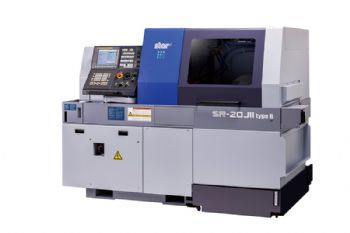
#MACH2018 Derbyshire-based Star Micronics GB Ltd (
www.stargb.com) — a supplier of CNC sliding-head lathes — unveiled its SR-20JII, which is an upgrade of its SR-20 J Swiss-type automatic lathe and uses a modular design and production system to reduce the lead time required for development and manufacture.
Features include a slant-type guideway structure, a gang-type tool-post for front-end working and a high-specification easy-to-use Fanuc 32iB control with a 10.4in LCD display.
A total of up to 30 cutting tools are available, including 14 driven tools for cross-drilling, milling, slotting and angular-hole machining (‘deep drilling’ stations allow holes up to 10mm in diameter x 100mm deep to be machined on the main spindle). The machine also features guide-bush/non-guide-bush options.
Also making its debut was the larger SR-32JII Type B sliding-head lathe which offers higher accuracy than its predecessor (the SR-32J), plus greater rigidity and increased productivity.
The eight-station back-working platen with Y2 axis increases “overlapping” opportunities to reduce cycle times and increases the total number of tools that can be mounted to 39.
Flexibility has also been enhanced with the ability to switch between guide bush and non-guide bush modes. Spindle performance has also been increased with more speed and power.
In addition, hydraulic clamping for the main spindle and sub-spindle collets has been adopted, which increases the clamping force by up to 40%.
Machine rigidity has been increased by the use of dovetail slideways on the X1, Y1, Y2 and Z2 axes.
Star GB also introduced its new HFT (high-frequency turning) software at
MACH.
The company says that HFT increases machine efficiency on difficult-to-chip materials by allowing intermittent cutting on any linear axis; this breaks up ‘stringy’ swarf into more-manageable smaller chips and facilitates ‘lights out’ running.
It can be applied to the X, Y and Z axes and is suitable for a range of machining techniques, including turning tapers and arcs, as well as drilling. Moreover, the software can be easily enabled or disabled.